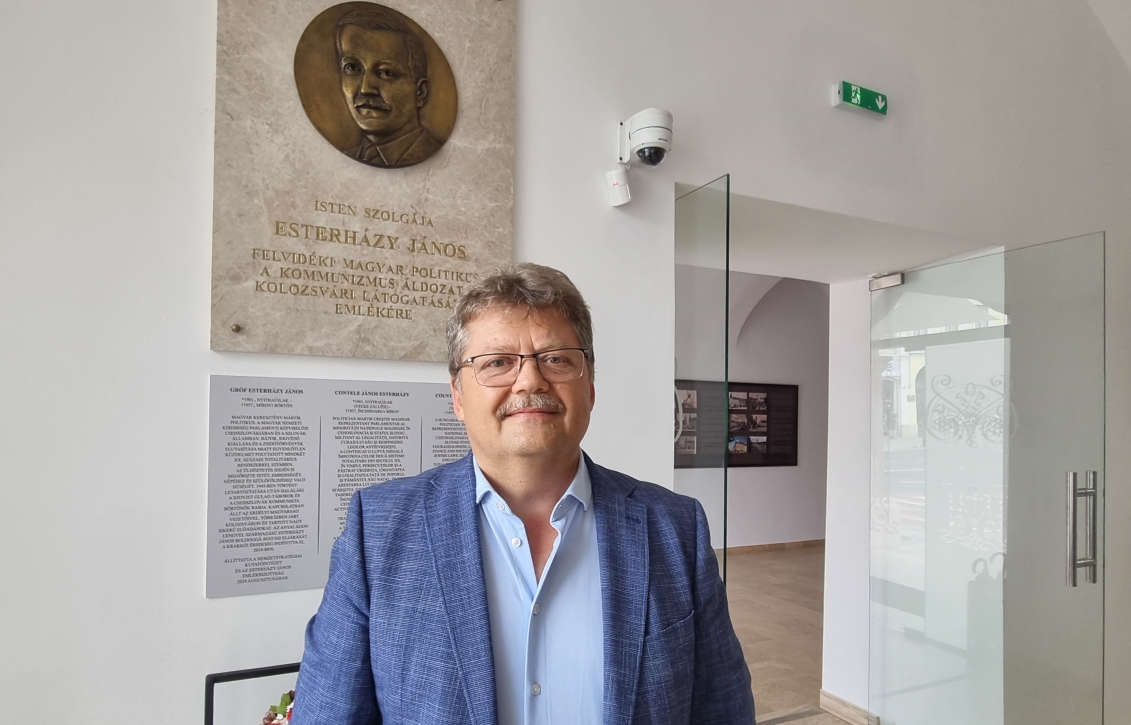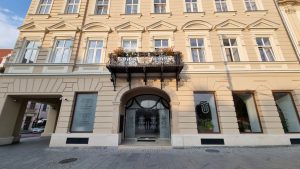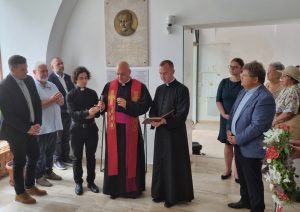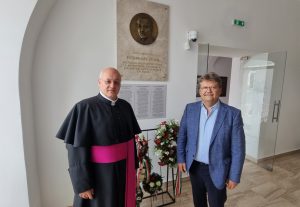
St Michael's Church was awarded the Europa Nostra prize this year.Continue reading

The Hungary Today team has visited the central town of the Transylvanian-Hungarian community, Cluj Napoca, Kolozsvár in Hungarian, during the unveiling of a memorial plaque for our martyr politicians, Count János Esterházy. As the Sapientia University along with the National Strategic Research Institute gave home to the memorial, we took the opportunity to speak with its president and founding president of the Hungarian Civic Party (MPP), Jenő Szász, after the unveiling ceremony.
What is a “national strategy”? Could you also say a few words about the National Strategic Research Institute (NSKI)?
The 20th century practically dismantled the institutions of national unity during the years of communism. The Peace Treaty of Trianon (1920) itself left us a legacy that institutionalized this fragmentation. Therefore, now that ‘more blessed times’ have come, when we live in freedom, our task is to try to repair what the 20th century tore apart, albeit with the tools of the 21st century. The mission of the National Strategic Research Institute is to reformulate this historic heritage. Hence in the context of the 21st century, it is using contemporary tools to try to reweave the fabric of the nation, our sense of belonging together. It is good if this purpose is served by institutions, even if these can be symbolic in nature.
Here at the NSKI, we do not necessarily have to think of an institution housed within a building as such, but in terms of a mission for spiritual rejuvenation and national unity. If we set out to remember Count János Esterházy here in Transylvania, the martyred politician from the Highlands (Slovakia), then we are also trying to set an example of him, the way he took a stand by making sacrifices for his people, or by facing his fate. If you are trying to look for examples in this unstable, uncertain world, it is good to set such firm points.
When the ground is unsteady, it is important to set some “anchors”, so that we can still walk the path that God has set out for us.
If we can set such historical greats as examples from a national point of view, then this is a handhold that can really be a true point of support for all of us.

The Sapientia University in Cluj-Napoca. Photo: Hungary Today
Especially among the ranks of the younger generation, Esterházy’s message has a very strong competitor: a global identity that is not tied to a particular religious orientation, not tied to national traditions, while Esterházy’s message is precisely the message of St Stephen, that of remaining Hungarian, of remaining Christian. Do you think that you can still compete with this message, especially for the hearts of young Hungarians in Transylvania?
As God has entrusted me with three wonderful children, it is important to think with their minds and to be alert and watchful of what is on their minds. I see it as a very great challenge for young people today to be able to define their own mission, so that they can bring out their true self. From that point of view, they need to be set on a certain path. This is the responsibility of parents and grandparents.
There is no path that is more practicable, more secure, more well-trodden, more tried and tested than the path that we inherit from our parents and grandparents.
You have mentioned – quite rightly – the legacy of King St Stephen (975-1038), which János Esterházy carried on. With his life and work he confirmed that it is possible, that it was possible to realize this even under the difficult circumstances (WWII, ed. note) that Esterházy had to face. For us, in a certain sense, when communism was in its repressive years, and my generation had already experienced some of that, it was in some ways easier, because we knew that God, the church and faith were our footholds, especially for us national minorities. For us Hungarians in Transylvania, in the years of communist repression, and during the time of Romanian leader Nicolae Ceaușescu, this was the anchorage. We lived in our faith as a nation, and the path we should take, or the path worth taking, was clear, or clearer.
Our parents, our grandparents, therefore, lead our hands towards prayer, in order to give us this kind of foothold as an opportunity.
Now that we live in freedom, it is in some ways more difficult. I do not envy today’s young people in this respect, because when the whole world enters our children’s rooms through the Internet, when it is present in the homes of every Hungarian family, there are so many temptations that it is really difficult to find the right path and the right direction. On the one hand, this is a serious challenge, and on the other hand, it is a great responsibility for all those who nurture and help these young people and children along this path. Therefore, the responsibility of parents is really of paramount importance. It is important for parents, teachers, educators, our schools and cultural institutions to show that it is good to be Hungarian and to remain Hungarian, there is no other way. The great lesson to be learnt from each and every one of these challenges is that we should try, if possible, to give young people good advice in this direction.

Unveiling of a memorial plaque for the martyr politician, Count János Esterházy. Photo: Hungary Today
Hungarians from Slovakia now formally “handed over” the legacy of János Esterházy for the edification of Hungarians in Romania. Who could the Hungarians of Transylvania offer from among their ranks in return who would have the same constructive, unifying power?
We are in the neighborhood of the church of St. Michael. He is the patron saint of Transylvania and the patron saint of the archdiocese of Alba Iulia (Gyulafehervár). Our martyred bishop Áron Márton (1896-1980) served in this parish, and if a parallel is to be drawn between an example to be followed in Slovakia and one in Transylvania, then I think that we can place our Áron Márton next to János Esterházy.

With deacon Attila László (L) during the unveiling of a memorial plaque for Count János Esterházy. Photo: Hungary Today
How could we spread the legacy of Áron Márton in Hungary or in Slovakian locations?
I would refer you to our Gallery of Carpathian Home. There we organized an exhibition for one hundred contemporary artists in Budapest. One hundred exhibitions in total, because it was one hundred years after Trianon when we finished this program. And the message of this was that we Hungarians belong together, and the artists expressed this by showcasing their works. We published joint albums, so that we could display and present it to the world today, not only to Hungarians, but to people who love culture in general. The Esterházy Academy in Slovakia is working with some support from the NSKI. In Szeklerland here in Romania, the NSKI runs the Balázs Orbán Academy, and now we should perhaps also take the opportunity for a pledge to create and Academy of Áron Márton.

The Church of Saint Michael in Cluj-Napoca. Photo: Hungary Today
Here in Cluj Napoca, perhaps?
It could be here in Cluj, so that it has a real impact on Szeklerland, and thus the whole of Transylvania. It should have a mission to popularize our heritage through scientific, cultural, or social means, just like the Esterházy Academy does in Slovakia. For us here in Transylvania it would be important to get to know Esterházy even more deeply, and in this respect I am grateful to God and to his servant, Archdeacon Attila László, and also to Sapientia University for accepting our memorial plaque. This initiative shows that we Hungarians really do belong together. If, starting from this moment, we can bring something of the teachings of Áron Márton to Slovakian Hungarians, then these two Hungarian saints will come together through our work, through the work of all of us. This can strengthen not only Hungarian heritage, but also stand as an outstanding example for our young people.
Both titular archbishop Áron Márton, and János Esterházy’s spiritual legacy contain a universal element that could be adopted and cherished even by non-Hungarians. What would be the one idea, either from the work of Áron Márton or János Esterházy, that you would highlight and say that this is what we can offer as an example to our readers in the West, or indeed in the East?
It is their Catholic faith, because it is a universal faith, and clinging to God alone is what can really be a real crutch for every single person, not just Hungarians. And if we can give our dear readers and listeners some kind of encouragement, we would say that they should
trust in God and that the language of love, the commandment of love, is perhaps our most important heritage from God, which can also be our mission.
And if we seek to serve the good that comes from that, each in our own language and in our own cultural community, then that is the common language on which to build.
Featured Image: Hungary Today